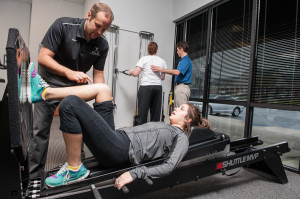
06 Jun Preoperative Therapy Becoming More Popular
Rehabilitation therapy following a major orthopedic procedure such as knee or hip replacement has been standard for many years. But the latest trend to reduce postoperative recovery time and improve the quality of the recovery overall is preoperative physical therapy, or “prehabilitation.”
Physical therapist and certified athletic trainer Ryan Schallenberg is a proponent of prehabilitation, and not only with his fit, young patients, but with seniors, as well.
“The goal is to get as much motion, strength and function as you possibly can before surgery,” Schallenberg says, “and to learn as much as you can about managing the condition after the surgery,” such as how to safely use crutches or a walker.
Pick prehabilitation
Prehabilitation is part of an overall training and education experience offered at various hospitals, clinics and centers that address orthopedic issues.
Information may be introduced in a group class led by a physical therapist or other health professional.
Then individual sessions may be offered with the physical therapist. And depending on the location, procedure and insurance coverage, postoperative therapy is offered either during or after the hospital stay.
Sometimes, prehabilitation stretching and strengthening exercises actually help avoid surgery, says Schallenberg.
But if not, before a scheduled surgery, patients usually will come for two to four weeks, once or twice a week, for 45- to 60-minute sessions of combined manual therapy that includes the physical therapist’s hands on the patient (stretching legs, for example, to extend range of motion) and strengthening exercises that also can be done at home.
The exercises are designed to increase range of motion, strength, body awareness, balance and function.
“Prehabilitation is not a bad thing for anyone going through a major procedure, but especially when it’s the first time, such as the first knee or hip replacement. I strongly recommend it,” says Schallenberg.
According to the American Physical Therapy Association’s website, http://www.apta.org, “the better physical shape you are in before total knee replacement surgery the better your results will be (especially in the short term).
“Before surgery, your physical therapist will teach you exercises and show you how you will walk with assistance after your operation. Your therapist also will discuss precautions and home adaptations,” such as removing loose rugs and more.





